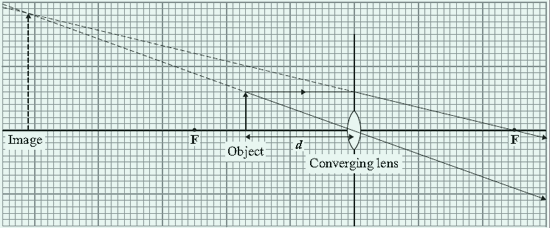GCSE level optics questions
Q10.
A student investigates how the magnification of an object changes at different distances from a converging lens. The diagram shows an object at distance d from a converging lens.

(a)
(i) The height of the object and the height of its image are drawn to scale. Calculate the magnification produced by the lens shown in the diagram. Show clearly how you work out your answer.
(2 marks)
(ii) The points F are at equal distances on either side of the centre of the lens. State the name of these points.
(1 mark)
(iii) Explain how you can tell, from the diagram, that the image is virtual.
(1 mark)
(b) The student now uses a different converging lens. She places the object between the lens and point F on the left. The table shows the set of results that she gets for the distance d and for the magnification produced.
Distance d /cm |
Magnification |
5 |
1.2 |
10 |
1.5 |
15 |
2.0 |
20 |
3.0 |
25 |
6.0 |
Herfriend looks at the table and observes that when the distance doubles from 10 cm to 20 cm, the magnification doubles from 1.5 to 3.0. Her friend's conclusion is that:
"The magnifi cation is directly proportional to the distance of the object from the lens." Her friend's observation is correct but her friend's conclusion is not correct.
(i) Explain, with an example, why her friend's conclusion is not correct.
(2 marks)
(ii) Write a correct conclusion.
(1 mark)
(iii) The maximum range of measurements for d is from the centre of the lens to F on the left. The student cannot make a correct conclusion outside this range. Explain why.
(1 mark)
(Total 8 marks)



